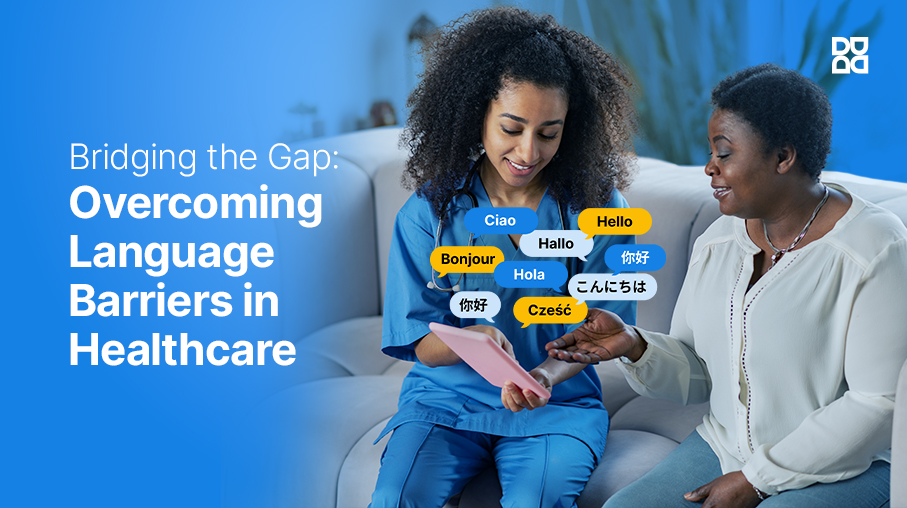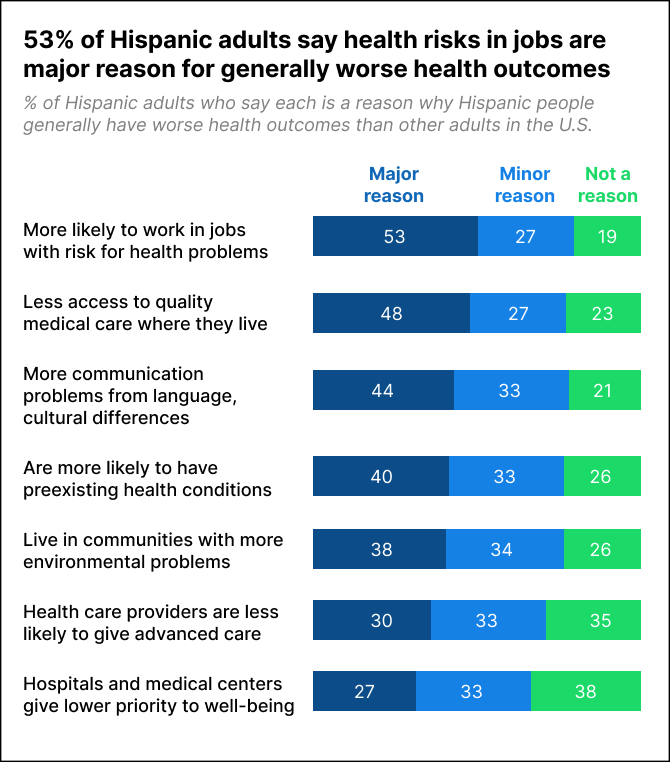
25 million Americans with Limited English Proficiency (LEP) face challenges accessing care.
Despite societal efforts, there are still many health disparities, including language barriers in healthcare, that adversely affect the quality of care and patient satisfaction. It can be especially true for minority groups belonging to specific ethnicities, races, or communities.
Do You Know How Automated Debt Recovery Can Transform Your Business’s Bottom Line?
As a result, many leading healthcare practices are leaning towards including multi-language support and technologies for overcoming language barriers in healthcare to boost patient access and foster health equity.
In this blog, let's discuss the impact of these challenges and how to counteract them with Denefits healthcare payment plans.
How Do Language Barriers Affect Healthcare?
As per the U.S. Census Bureau, as of 2022, around 42.5 million people in the U.S. speak Spanish as their native language, which is 13.4% of the nation's population. However, language barriers affect approximately 25 million Spanish speakers in the U.S., keeping them from accessing quality healthcare.
In fact, many research studies show that over 65% of patients who face cultural and language barriers in healthcare communication are often dissatisfied with the treatment they receive. It is essentially the biggest challenge for immigrants, refugees, and other minorities in the U.S.

The Risks of Healthcare Language Barriers
For Patients
Language hurdles make patients more prone to:–
▶️Misdiagnosis
Patients who don’t speak and understand English may face more problems communicating their needs. Hence, the provider may not know some crucial information that could help correctly diagnose them.
It can sometimes lead to a misdiagnosis. Additionally, the language barriers may necessitate tests that otherwise would not have been necessary if the providers could easily understand and diagnose the issue by communicating with the patient.
▶️Poor Understanding of Instructions
Many studies indicate that if there is a lack of understanding between the patient and provider, it can be difficult for patients to follow the instructions provided by the staff. It can make it challenging to provide the right care that a patient needs.
▶️Treatment Risks
Healthcare providers need to ensure that the patient understands their treatment options. Patients should also be well aware of the risks associated with the treatment. However, having lingual differences may prevent them from fully understanding the benefits and risks.
▶️Perceived Discrimination or Feeling Misplaced
Language differences may cause more stress for patients, and they may feel like they are not being heard. It can make them feel overlooked, misplaced, or even like they are being discriminated against. In fact, 20% of patients avoid seeking medical help altogether due to a lack of confidence in discussing healthcare concerns.
For Healthcare Providers
Language barriers affect the provider’s ability to provide care in the following ways:–
▶️Collecting Patient Information
Providers typically need to gather relevant information from the patients. For instance, medical history, allergies, and other relevant information help them make an accurate diagnosis. 80% of the health assessment depends on the patient’s ability to communicate their symptoms to get the right care.
However, if providers can’t understand what the patient is saying, it may prevent them from accurately diagnosing the issue and delay the diagnosis process. As a result, it can lead to treatment delays and increase health risks for patients.
▶️Challenges With Medication
If the patient can’t properly tell the provider their issues, they may be prescribed unnecessary medications, as the provider may only be able to go on with trial and error. However, it may put patients at risk.
When patients face language barriers, they may not be able to properly adhere to medical advice. There are many cases where the patient may not complete the treatment plan due to a lack of understanding, or they may face difficulty following through with repeat visits prescribed by the physician. Hence, it can reduce the effectiveness of the treatment.
▶️Documentation Errors
It is a common issue for practices when there’s a language gap, especially when treatment requires explicit consent. In such cases, providers may make critical decisions to treat the patient, and patients may feel excluded from making informed decisions. Moreover, ambiguous consent raises concerns and may even lead to legal consequences for the practice.
▶️Understanding Payment Options
Language barriers can drive up the cost with the need for extensive testing. Additionally, most times, it’s the refugees, immigrants, and immigrants who need the most financial support, as they may not be eligible for insurance. However, if they are unable to understand the language they may not be able to learn about the viable payment options that can help them afford the cost in more manageable installments.
How To Overcome Language Barriers In Healthcare?
Healthcare providers can take proactive steps to minimize the impact of language barriers in healthcare and ensure they provide the best possible care. Here are a few tips that can help providers meet the needs of patients by providing a higher quality of care, accurate diagnosis, eliminating complications, and ensuring patient satisfaction.
Top 4 Solutions to Language Barriers in Healthcare
1. Bilingual Staff
One of the best ways to reduce language disparity is by hiring staff such as nurses and doctors who can speak and understand diverse languages. As Spanish is the most widely spoken language other than English, hiring bilingual staff is a great way to ensure more people can easily communicate with healthcare professionals without needing an interpreter.
Additionally, the bilingual staff can train the other staff to handle situations where they may face language barriers by teaching them some basics for emergencies.
2. Medical Interpreters
Sometimes patients may bring a friend, neighbor, or someone else to interpret. However, they may not be aware of the medical terminology and can only provide limited assistance. Hence, it's a smart idea to have a medical interpreter who is well-versed in speaking different languages and can explain medical terminology well.
3. Multilingual Medical Payment Solution
While hiring staff that can speak diverse languages and medical interpreters can help reduce communication barriers, it still can’t help ease the financial burden on patients. Thus, to ensure providing all-round quality care, integrating a multi-lingual patient payment plans in your practice, such as Denefits, can go a long way. It makes it easier to offer ‘No Credit Check’ healthcare payment plans that can help them better manage their healthcare expenses.
4. Multilingual Integration on the Website
Embracing multilanguage technology in all aspects of healthcare, including the website, can help reach more patients.
| Multilingual websites can help reach 75% more people who don’t speak English and boost conversions up to 70%. |
Denefits’ tailored plans in different languages enable providers to cater to the language preferences of various ethnic and cultural groups. Hence, they can expand their reach and attract new patients who may have previously been overlooked.
Denefits' Multilingual Capabilities and Impact on Healthcare Access
Denefits is a leading payment solution that allows providers to offer their patients ‘No Credit Check’ payment plans. Hence, it plays a vital role in making healthcare expenses more manageable for patients from diverse financial backgrounds. Additionally, its multi-language capabilities make it the perfect solution to offer flexibility in payments to those with limited access to healthcare due to language and financial barriers.
Here’s how:
➡️Bridge Communication Gap
Language barriers often lead to misunderstandings regarding treatment plans and instructions. With Denefits’ multi-language features, patients can better comprehend the available payment options with relevant information in the language they prefer. Hence, it increases patient understanding, leading to informed decisions.
➡️Inclusive Patient Experience
Spanish speakers, immigrants, and minorities struggle to avail the right treatment options due to language differences. A multilingual approach promotes cultural sensitivity. It creates a more comfortable and inclusive patient experience, eliminating nuances.
➡️Build Stronger Connections
As per CSA Research, 65% of users prefer content in their native language. It helps foster trust, and they are more likely to choose a provider with language inclusivity, promoting better relationships.
➡️Improved Conversions & Global Impact
When patients can access the relevant information in their own language, it makes it easier for them to browse payment options and follow through with recommended healthcare services, leading to higher conversion rates for the practice. Additionally, multi-language support not only expands the reach to locals but can also help make a global impact.
➡️Legal Compliance
According to the Affordable Care Act, any healthcare facility that receives federal assistance must take reasonable steps to ensure quality care for patients with limited proficiency in English. Additionally, it mitigates legal risks and demonstrates compliance with relevant regulations.
➡️Competitive Advantage
The multilingual approach also gives providers a competitive advantage by creating a reputation for catering to diverse patients. Patients are more likely to recommend providers who are known for inclusive practices.
Final Thoughts
Many patients with limited proficiency in English, such as native Spanish speakers and those from diverse linguistic backgrounds, often struggle with communication at the front desk. This extends to communication during the appointment, payment process, and other interactions.
As a result, it can lead to miscommunication about getting the right treatment and a lack of awareness about payment options. Those who belong to marginalized communities often face more barriers to essential care as a result of it.
Additionally, many of those individuals cannot qualify for insurance, and with the added burden of medical bills, most avoid or delay care unless it is life or death. However, taking steps such as bilingual staff, and medical interpreters, and integrating language-inclusive technologies like the Denefits payment solution can boost the patient experience and help reduce language barriers to a great extent.
To learn more about how Denefits can help enhance healthcare accessibility for patients with multi-language support, reach out to us or schedule a demo today!
1. What are the common barriers to communication in healthcare?
There are many obstacles to effective healthcare communication, including
- Language Barriers
- Cultural Differences
- Emotional Barriers
- Attitude And Perceptual Barriers
- Lack Of Education & Low Literacy
- Patient Distrust
- Lack of multi-language technology (especially for payments)
Among these, language barriers are the most prevalent.
2. How do language barriers create a health disparity?
Language barriers limit access to valuable healthcare information for patients, leading to miscommunication, and delays in care. Additionally, they increase the risk of misdiagnosis, put patient safety at risk, and reduce access to quality care, creating health disparity.
3. What Is Health Equity?
Health equity stands for equal access to healthcare services for everyone. However, many patients often experience below-par access to healthcare due to a range of factors, including socioeconomic standing, location, access to insurance, and linguistic barriers.
4. How To Leverage Denefits To Promote Healthcare Access To Non-English Speakers?
Denefits ensures that non-English speakers can easily understand and navigate the payment process with its multi-language support. Additionally, its flexible payment plans help promote inclusivity and accessibility for patients from diverse backgrounds.


